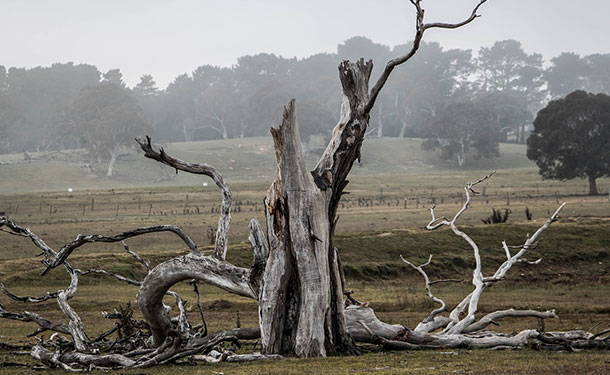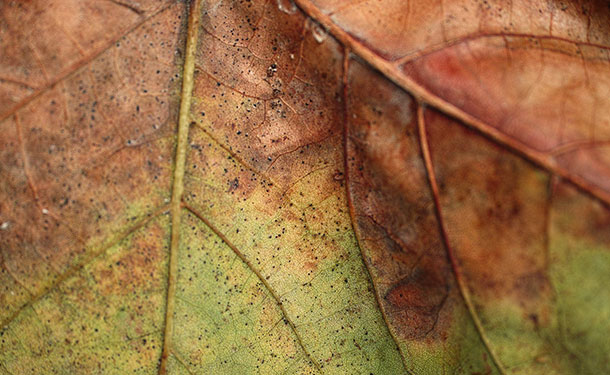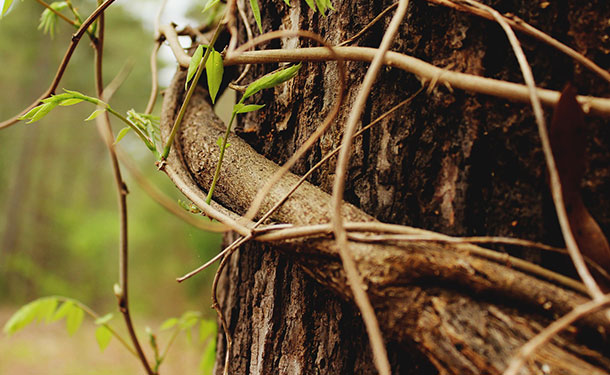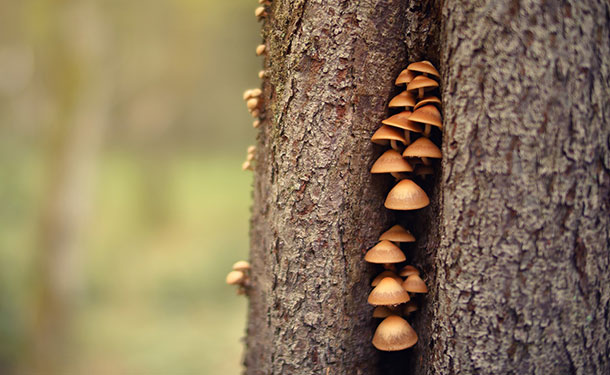Your dying tree could cause catastrophic, life-threatening damages if it falls on your property. By knowing how to identify the signs of a dying tree, you can take swift action to restore its health or minimize its threat.

thetreecareguide.com gathered information on signs that indicate your tree is dying, and what you can do to help it.
Leaf Discoloration (Chlorosis)
One of the first signs that your tree is dying is the offseason loss of color, drying out, or premature leaf drop. The canopy of a healthy tree is full and vibrant, consider the following disorders or deformities when looking at your tree:
Leaf Deformities – When a tree is stressed by infestation or disease, it will likely produce smaller, deformed leaves.
Chlorosis – This condition is the loss of color in a tree’s foliage. It can be caused by multiple diseases or boring insect infestations. When chlorosis occurs, bright, green leaves will give way to yellowish-brown sickly-looking leaves.
Foliage Wilt – When a tree’s leaves wilt, it is an indication of hydraulic failure and/or drought.
Foliage Death – If leaves are quickly wilting and dying, but not falling off of your tree, this is a sign of a fast-acting pathogen within your tree.

Early Leaf Drop – When leaves fall from your tree prematurely, especially if they are falling while still green, your tree may be experiencing hydraulic failure and impending death.
Note: The way trees are structured, infection or infestation can devastate a portion of the tree and leave the rest of it unaffected.
If any of these conditions are apparent in your tree’s foliage, contact a professional tree service to evaluate your tree, gather more information, and offer treatment suggestions.
Dead Branches
As a disease or infestation advance within a tree, not only will its foliage show signs of trouble, but entire branches can die. However, some tree species are self-pruning, and while they may appear to be dying or in trouble, they are simply shedding unneeded branches.
When multiple branches appear to be dying, those branches should be marked for removal during the next pruning season.
If those branches show signs of disease (cankers, mushroom conks, etc.) or insect infestation (sawdust or exit holes from boring insects), do not wait for the pruning season. These branches should be immediately pruned off of the tree.
Tip: Use your fingernail or a sharp knife to scrape a small area of bark from the branch. A live branch will display a green, moist cambium layer beneath the bark, while a dead branch will be brown and dry beneath the bark.
Note: Dying or dead branches can fall at any time. These branches should be removed from your tree to avoid catastrophic damages should they fall.
Bark Irregularities
Tree bark should seamlessly wrap around a tree’s trunk and limbs. If the following are present in the bark, your tree may be in rapid decline:
- Cankers (open wounds oozing fluids)
- Deep cracks (sign of the tree drying out)
- Large swollen or bulging areas (sign of festering disease)
- Sunken, discolored areas of bark (sign of sunscald)
- Woodpecker damage (they search for beetles)
- Exit holes from a beetle infestation
- Sloughing bark (sign of hydraulic failure and dying cambium layer)
- Ropes, chains, or vines tightly wrapped around the trunk (girdling it)

Tree bark problems can spread throughout a tree quickly and require accurate, professional diagnoses, and treatment.
For more information about how vines can ravage a tree’s health, read thetreecareguide.com/climbing-vines-tree-killers/
Tree Architecture
Healthy trees usually grow symmetrically with sturdy branch to trunk unions/joints. If your tree is lopsided or is leaning, this can be a sign of declining health or severe root damage.
Especially in cases where the tree is leaning, emergency tree removal may be the only option to protect your property and well-being.
Root damage is the likely culprit of problems with a tree’s architecture. Consider the following:
- Surface roots are easily damaged by foot traffic or landscaping equipment
- Compacted soil can suffocate and kill roots – read more at thetreecareguide.com/soil-compaction-solutions/
- Disease or infestation can cause root rot
- Poorly-drained soil can also cause root rot
If the problem with your tree is limited to lopsided growth, consult a trusted tree service about crown thinning and pruning to encourage growth in a specific direction. Read more about pruning purpose and techniques at thetreecareguide.com/tree-pruning-purpose-techniques-safety/
Insect Infestation and Disease
While trees have developed natural defensive mechanisms over millennia of evolution, opportunistic insects can successfully attack stressed trees or those already in decline. In many cases, severe damage occurs with repeated attacks over multiple growing seasons. Some of the most destructive insects to tree health include:
- Aphids (damage to foliage and stems)
- Scale (damage to foliage and stems)
- Adelgids (consumes sap causing loss of foliage)
- Caterpillars and Moths (heavy consumption of foliage)
- Beetles (interrupt the flow of water and nutrients by consuming the cambium layer, rapidly killing the tree)
- Borers (create chambers in the cambium layer and chew into heartwood, rapidly killing the tree)
The best way to prevent insect infestations is to promote the health of your trees and treat them with insecticides. When a boring insect or beetle outbreak is detected in your region, schedule more frequent inspections of your trees. Consult an ISA certified arborist about treating your trees during such an outbreak. Infested trees in decline and deemed unsalvageable should be quickly isolated and removed.
When it comes to fungal or bacterial infections, look for the following signs:
- Cankers (discolored, damaged areas or depressed places on the bark)
- Mushrooms growing around the base of the tree
- Mushroom plumes or conks attached to the root flare or trunk
- Carpenter ants nesting inside the trunk or branches (these opportunistic ants remove decayed pulp but do not chew at the heartwood)

These are signs of dangerous rot in the roots or trunk. With time, decay will extend further within the tree’s heartwood leading to the tree’s death and potential collapse. It is highly recommended that diseased trees be evaluated and treated by a professional tree service immediately.
Signs of a Tree in Decline
In this article, you discovered the many indicators of trees in decline and how to deal with them before they kill your tree.
By knowing how to identify tree problems early and who to call for help, the chances of saving your tree significantly increase.
Being uninformed about tree diseases, insects, and signs of decline could cost you when your tree collapses on your property, causing unfathomable damages.
Sources:
extension2.missouri.edu/g5200
extension.uga.edu/publications/detail.html?number=C1100
tcia.org/TCIA/Blog_Items/2014/What_To_Do_When_Your_Tree_Is_Dying.aspx
pace.oregonstate.edu/courses/sites/default/files/resources/pdf/treeprobs.pdf
bostonglobe.com/metro/2016/04/10/how-assess-whether-tree-decaying/PMsTVFNYn9JvVUY8JuATLK/story.html